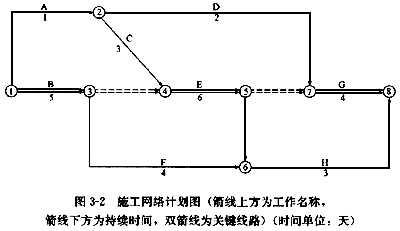与某建筑公司(乙方)订立了某工程项目施工合同,同时与某降水公司订立了工程降水合同。甲、乙双方合同规定:采用单价合同,每一分项工程的实际工程量增加(或减少)超过招标文件中工程量的10%以上时调整单价;工作B、E、G作业使用的主导施工机械一台(乙方自备),台班费为400元/台班,其中台班折旧费为50元/台班。施工网络计划如图3-2所示。

甲、乙双方合同约定8月15日开工。工程施工中发生如下事件:
事件1:降水方案错误,致使工作D推迟2天,乙方人员配合用工5个工日,窝工6个工日。
事件2:8月21日至22日,场外停电,停工2天,造成人员窝工16个工日。
事件3:因设计变更,工作E工程量由招标文件中的300m3增至350m3,超过了10%;合同中该工作的综合单价为55元/m3,经协商调整后综合单价为50元/m3。
事件4:为保证施工质量,乙方在施工中将工作B原设计尺寸扩大,增加工程量15m3,该工作综合单价为78元/m3。
事件5:在工作D、E均完成后,甲方指令增加一项临时工作K,经核准,完成该工作需要1天时间,机械1台班,人工10个工日。
问题:
1.上述哪些事件乙方可以提出索赔要求哪些事件不能提出索赔要求回答并说明其原因。
2,每项事件工期索赔各是多少总工期索赔多少天
3.工作E结算价应为多少
4.假设人工工日单价为25元/工日,合同规定窝工人工费补偿标准为12元/工日,因增加用工所需管理费为增加人工费的20%。工作K的综合取费为人工费的80%。试计算除事件3外合理的费用索赔总额。
参考答案:
对是否可以提出索赔要求的判定如下:
事件1可提出索赔要求,因为降水工程由甲方另行发包,是甲方的责任。
事件2可提出索赔要求,因为停水、停电造成的人员窝工是甲方的责任。
事件3可提出索赔要求,因为设计变更是甲方的责任,且工作E的工程量增加了50m3,超过了招标文件中工程量的10%。
事件4不应提出索赔要求,因为保证施工质量的技术措施费应由乙方承担。
事件5可提出索赔要求,因为甲方指令增加工作,是甲方的责任。
2.工期索赔天数为:
事件1:工作D总时差为8天,推迟2天,尚有总时差6天,不影响工期,因此可索赔工期0天。
事件2:8月21日至22日停工,工期延长,可索赔工期2天。
事件3:因E为关键工作,可索赔工期:(350-300)÷(300÷6)=1(天)。
事件5:因G为关键工作,在此之前增加K,则K也为关键工作,索赔工期1天。
总计索赔工期:0+2+1+1=4(天)
3.工作E的结算价:
按原单价结算的工程量:300×(1+10%)=330(m(上标)3)
按新单价结算的工程量:350-330=20(m(上标)3)
总结算价=55×330+50×20=19150(元)
4.费用索赔总额的计算:
事件1:人工费:12×6+25×5×(1+20%)=222(元)
事件2:人工费:12×16=192(元)
机械费:50×2=100(元)
事件5:人工费:25×10×(1+80%)=450(元)
机械费:400~1=400(元)
合计费用索赔总额为:222+192+100+450+400=1364(元)
